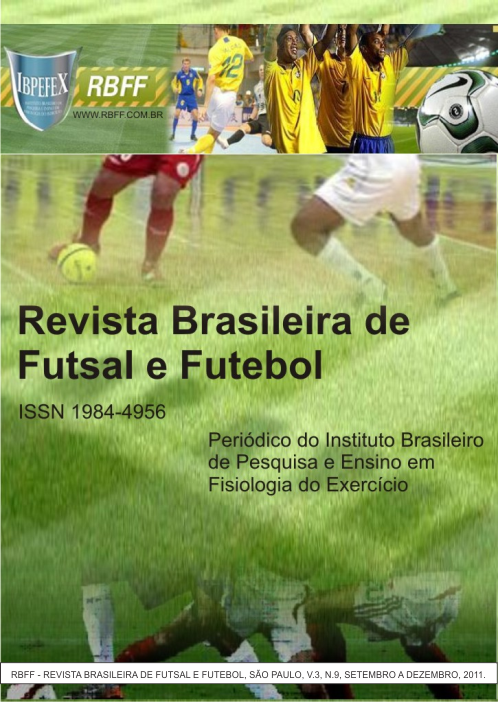The effect of the year competition and new cycle of phisical capacity in periodization football players
Abstract
The aim ofthis study was to evaluate the effects of the competitive period (10 weeks) compared to the post-preparation period (9 weeks). In addition, was evaluated the influence of 10 days of vocation and new praparatoty cycle (pre and post) for the next competition, through the measurement of physical capacity required during the game. For this, was quantified the distance of horinzontal jump (SH), anaerobic threshold (LA), numbers of sprints (NS), avarege velocity at 30 m (V30), maximum velocity (Vmax) and acceleration time (TA). Our results showed that the values of physical capacity measured were not significantly (p > 0,05) affected by the competition period, suggesting that the frequency of one weekly game would be appropriate to keep the physical stimulus for maintenance of the performance obtained before the beginning of competitions. After vocation period the values of physical capacity measured were not reduced, suggesting that the time of 10 days was not enough to generate detraining in the physical capacity evaluated and which can favor the recovery of muscular stress. In conclusion, the results of this study indicate that muscle performance and aerobic and anaerobic capacities can be maintained throughout the competitive period, performed with the frequency ofa weekly game. The recovery period of 10 days was insufficient to generate detraining on evaluated physical capacity, ‘indicating recovery of physical stress obtained during the competitive period.
References
-Arruda, M.; Goulart, L.; F. Oliveira, P.; R. Puggina, E.F.; Toledo, N. Futebol uma nova abordagem de preparação física e sua influência na dinâmica da alteração dos índices de força rápida e resistência de força em um macrociclo. Treinamento Desportivo, Vol. 4, Núm. 1, p. 23-28. 1999.
-Byrne, C.; Twist, C.; Eston, R. Neuromuscular function after exercise-induced muscle damage. Sports Med, Vol. 34, Núm. 1, p. 49-69. 2004.
-Lazarim, F.L.; Antunes-Neto, J.M.; Silva, F.; Nunes, L.; Bassini-Cameron, A. Cameron, L.; Alves, A.; Brenzikofer, R.; Macedo, D. The upper values of plasma creatine kinase of professional soccer players during the Brazilian National Championship. J Sci Med Sport, Vol. 12, Núm. 1, p. 85-90. 2009.
-Ide, B.N.; Lopes, C. R.; Sarraipa, M.F. Fisiologia do treinamento esportivo. São Paulo. Phorthe. 2010.
-Malder, P.; Cronin, J. Horizontal and vertical jump assessment: Reliability, symmetry, discriminative and predictive ability. Physical Therapy in Sport, v. 6, n. 2, Mai, p. 74-82. 2005.
-Mcmillan, K.J.; Grant, S.; Newell, J.; Macdonald, R.; Hoff, J. Lactate threshold responses to a season of professional British youth soccer. Br J Sports Med, Vol. 39, Núm. 7, p. 432-6. 2005.
-Mujika, I.; Padilla, S. Detraining: loss of training-induced physiological and performance adaptations. Part I: short term insufficient training stimulus. Sports Med, Vol. 30, Núm. 2, p. 79-87. 2000.
-Mujika, I. Padilla, S. Cardiorespiratory and metabolic characteristics of detraining in humans. Med Sci Sports Exerc, Vol. 33, Núm. 3, p. 413-21. 2001.
-Stolen, T.; Chamari, S.; Castagna, C.; Wisloff, U. Physiology of soccer: anupdate. Sports Med, Vol. 35, Núm. 6, p. 501-36. 2005.
-Tegtbur, U.; Busse, M.; W. Braumann, K.; M. Estimation of an individual equilibrium between lactate production and catabolism during exercise. Med Sci Sports Exerc, Vol. 25, Núm. 5, p. 620-7. 1993.
-Tumilty, D. Physiological characteristics of elite soccer players. Sports Med, Vol. 16, Núm. 2, p. 80-96. 1993.
-Ziogas, G.G.; Patras, K.N.; Stergiu, N.; Georgoulis, A. D. Velocity at lactate threshold and running economy must also be considered along with maximal oxygen uptake when testing elite soccer players during preseason. J Strength Cond Res, Vol. 25, Núm. 2, p. 414-9.
Authors who publish in this journal agree to the following terms:
- Authors retain the copyright and grant the journal the right of first publication, with work simultaneously licensed under the Creative Commons Attribution License BY-NC which allows the sharing of the work with acknowledgment of the authorship of the work and initial publication in this journal.
- Authors are authorized to enter into additional contracts separately for non-exclusive distribution of the version of the work published in this journal (eg, publishing in institutional repository or book chapter), with acknowledgment of authorship and initial publication in this journal.
- Authors are allowed and encouraged to post and distribute their work online (eg, in institutional repositories or on their personal page) at any point before or during the editorial process, as this can bring about productive change as well as increase impact and impact. citation of published work (See The Effect of Free Access).





